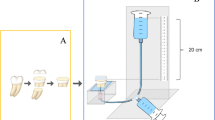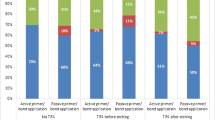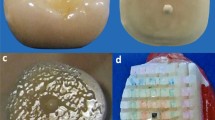Abstract
Objectives
To determine the effect on resin composite-to-dentin bond strength of incorporation of an acidic tin–chloride pretreatment in two adhesive systems.
Materials and methods
Human molars were ground to expose mid-coronal dentin. For microtensile bond strength (μTBS) testing, dentin was treated with Optibond FL or Clearfil SE according to one of six protocols (n = 22/group). Group 1: Phosphoric acid etching, Optibond FL Prime, Optibond FL Adhesive (manufacturer’s instructions; control); Group 2: Tin–chloride pretreatment, Optibond FL Prime, Optibond FL Adhesive; Group 3: Phosphoric acid etching, tin–chloride pretreatment, Optibond FL Prime, Optibond FL Adhesive; Group 4: Clearfil SE Primer, Clearfil SE Bond (manufacturer’s instructions; control); Group 5: Phosphoric acid etching, Clearfil SE Primer, Clearfil SE Bond; and Group 6: Tin–chloride pretreatment, Clearfil SE Primer, Clearfil SE Bond. The molars were then built up with resin composite (Clearfil Majesty Esthetic). After storage (1 week, 100 % humidity, 37 °C) the μTBS was measured and failure mode was determined. Additionally, pretreated dentin surfaces were evaluated using SEM and EDX. The μTBS results were analyzed statistically by a Welch Two Sample t-test and a Kruskal–Wallis test followed by exact Wilcoxon rank sum tests with Bonferroni–Holm adjustment for multiple testing (α = 0.05).
Results
When Optibond FL was used, partial or total replacement of phosphoric acid with tin–chloride decreased μTBS significantly. In contrast, when Clearfil SE was used, inclusion of a tin–chloride pretreatment in the adhesive procedure increased μTBS significantly.
Conclusions
Tin–chloride pretreatment had a beneficial influence on the bond promoting capacity of the MDP-containing adhesive system Clearfil SE.



Similar content being viewed by others
References
Van Loveren C (1990) The antimicrobial action of fluoride and its role in caries inhibition. J Dent Res 69:676–683, Special No
Van Loveren C (2001) Antimicrobial activity of fluoride and its in vivo importance: identification of research questions. Caries Res 35(Suppl. 1):65–70
Miller S, Truong T, Heu R, Stranick M, Bouchard D, Gaffar A (1994) Recent advances in stannous fluoride technology: antibacterial efficacy and mechanism of action towards hypersensitivity. Int Dent J 44:83–94
Paraskevas S, van der Weijden GA (2006) A review of the effects of stannous fluoride on gingivitis. J Clin Periodontol 33:1–13
Ganss C, Neutard L, von Hinckeldey J, Kilmek J, Schlueter N (2010) Efficacy of a tin/fluoride rinse: a randomized in situ trial on erosion. J Dent Res 89:1214–1218
Ganss C, Schlueter N, Hardt M, Schattenberg P, Klimek J (2008) Effect of fluoride compounds on enamel erosion in vitro: a comparison of amine, sodium and stannous fluoride. Caries Res 42:2–7
Ganss C, Lussi A, Sommer N, Klimik J, Schlueter N (2010) Efficacy of fluoride compounds and stannous chloride as erosion inhibitors in dentine. Caries Res 44:248–252
Ganss C, Lussi A, Grunau O, Klimek J, Schlueter N (2011) Conventional and anti-erosion fluoride toothpastes: effect on enamel erosion and erosion-abrasion. Caries Res 45:581–589
Huysmans MCDNJM, Jager DHJ, Ruben JL, Unk DEMF, Klijn CPAH, Vieira AM (2011) Reduction of erosive wear in situ by stannous fluoride-containing toothpaste. Caries Res 45:518–523
Schlueter N, Klimek J, Ganss C (2009) Efficacy of an experimental tin-F-containing solution in erosive tissue loss in enamel and dentine in situ. Caries Res 43:415–421
Ganss C, Hardt M, Lussi A, Cocks AK, Klimek J, Schlueter N (2010) Mechanism of action of tin-containing fluoride solutions as anti-erosive agents in dentine - an in vitro tin-uptake, tissue loss, and scanning electron microscopy study. Eur J Oral Sci 118:376–384
Flury S, Koch T, Peutzfeldt A, Lussi A, Ganss C (2013) The effect of a tin-containing fluoride mouth rinse on the bond between resin composite and erosively demineralised dentin. Clin Oral Invest 17:217–225
Lussi A (2006) Erosive tooth wear – a multifactorial condition of growing concern and increasing knowledge. Monogr Oral Sci 20:1–8
Tay FR, Sano H, Carvalho R, Pashley EL, Pashley DH (2000) An ultrastructural study of the influence of acidity of self-etching primers and smear layer thickness on bonding to intact dentin. J Adhes Dent 2:83–98
Van Landuyt KL, Kanumilli P, de Munck J, Peumans M, Lambrechts P, van Meerbeek B (2006) Bond strength of a mild self-etch adhesive with and without prior acid-etching. J Dent 34:77–85
Yoshida Y, Nagakane K, Fukuda R, Nakayama Y, Okazaki M, Shintani H, Inoue S, Tagawa Y, Suzuki K, de Munck J, van Meerbeek B (2004) Comparative study on adhesive performance of functional monomers. J Dent Res 83:454–458
van Meerbeek B, de Munck J, Yoshida Y, Inoue S, Vargas M, Vijay P, van Landuyt K, Lambrechts P, Vanherle G (2003) Buonocore memorial lecture. Adhesion to enamel and dentin: current status and future challenges. Oper Dent 28:215–235
de Munck J, Vargas M, Iracki J, van Landuyt K, Poitevin A, Lambrechts P, van Meerbeek B (2005) One-day bonding effectiveness of new self-etch adhesives to bur-cut enamel and dentin. Oper Dent 30:39–49
Fukegawa D, Hayakawa S, Yoshida Y, Suzuki K, Osaka A, van Meerbeek B (2006) Chemical interaction of phosphoric acid ester with hydroxyapatite. J Dent Res 85:941–944
Yoshiraha K, Yoshida Y, Nagaoka N, Fukegawa D, Hayakawa S, Mine A, Nakamura M, Minagi S, Osaka A, Suzuki K, van Meerbeek B (2010) Nano-controlled molecular interaction at adhesive interfaces for hard tissue reconstruction. Acta Biomater 6:3573–3582
Yoshida Y, Yoshihara K, Nagaoka N, Hayakawa S, Torii Y, Ogawa T, Osaka A, van Meerbeek B (2012) Self-assembled nano-layering at the adhesive interface. J Dent Res 91:376–381
Torii Y, Itou K, Nishitani Y, Ishikawa K, Suzuki K (2002) Effect of phosphoric acid etching prior to self-etching primer application on adhesion of resin composite to enamel and dentin. Am J Dent 15:305–308
Walker MP, Wang Y, Swafford J, Evans A, Spencer P (2000) Influence of additional acid etch treatment on resin cement dentin infiltration. J Prosthod 9:77–81
Acknowledgments
The authors would like to thank Gaba International AG, Therwil, Switzerland and Kuraray Europe, Germany for providing the materials needed. Furthermore, we thank J. Wandel and Prof. Dr. J. Hüsler, Institute of Mathematical Statistics and Actuarial Science, University of Bern for statistical analyses.
Conflicts of interest
The authors declare no conflicts of interest, real or perceived, financial or non-financial.
Author information
Authors and Affiliations
Corresponding author
Rights and permissions
About this article
Cite this article
Peutzfeldt, A., Koch, T., Ganss, C. et al. Effect of tin–chloride pretreatment on bond strength of two adhesive systems to dentin. Clin Oral Invest 18, 535–543 (2014). https://doi.org/10.1007/s00784-013-0975-6
Received:
Accepted:
Published:
Issue Date:
DOI: https://doi.org/10.1007/s00784-013-0975-6




